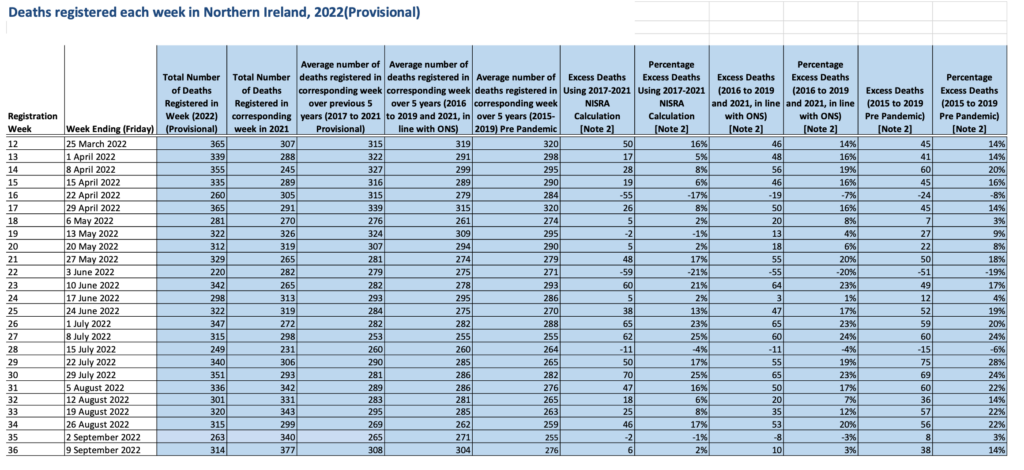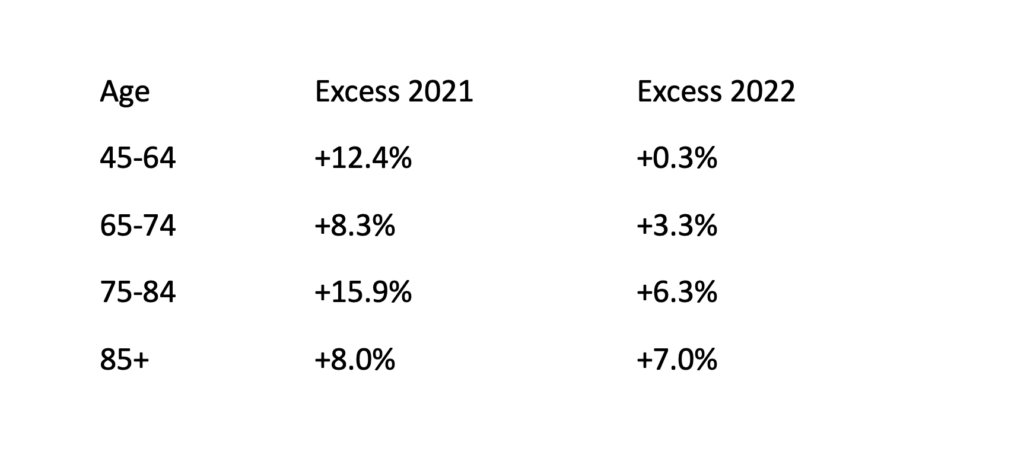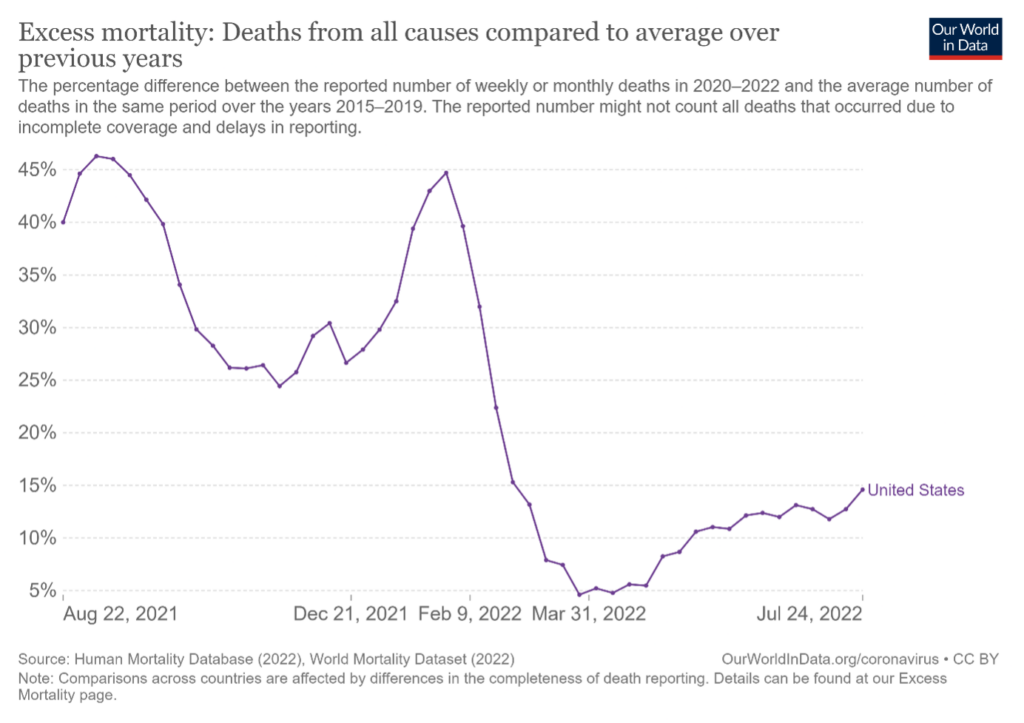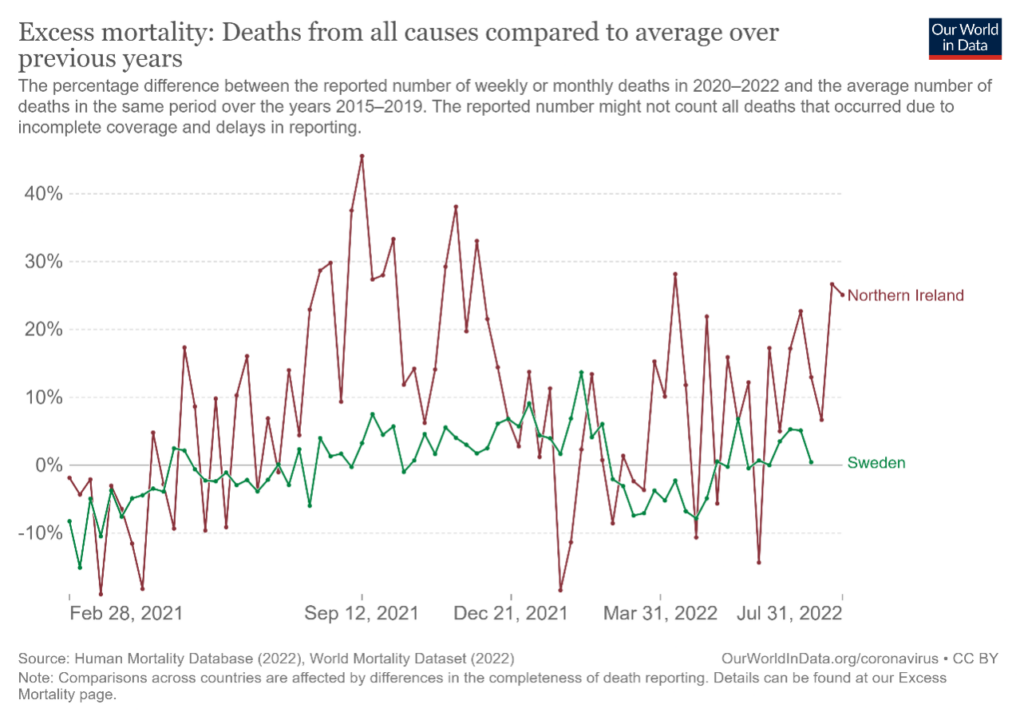The Problem With Excess Deaths
Since March 2022, Northern Ireland, and the UK as a whole, have been experiencing excess deaths over and above the 5-year-average (more people are dying than we would normally expect). But which 5-year periods are being used to calculate these averages? Even this issue has become a bone of contention.
Depending on which definition of the 5-year-average is used it can have a large impact on the level of excess deaths reported. At present, there are 3 variations of the 5-year-average being used across the world. The graph below shows how using different methodologies can skew the results.

In July this year DUP MLA Paul Frew received a reply from the Minister of Health Robin Swann stating that the excess death rate in Northern Ireland was “a significantly smaller increase than reported in England and Wales” and quoted the official NISRA statistics to back up this claim. However, it was discovered that NISRA were using a different 5-year-average calculation to the ONS who release statistics for England & Wales and our Minister of Health was not comparing the excess death rates on a like-for-like basis.
The ONS decided to omit 2020 from the 5-year average because the large number of Covid deaths in this year would skew the average upwards and reduce the excess death count, so they use 2016-2019 and 2021. This still skews the figures for the beginning of the year because of the higher than the normal death rate from the “second wave” at the beginning of 2021.
However, NISRA (Northern Ireland Statistics and Research Agency) have decided to include both pandemic years in their calculation and use a straight 5-year-average of 2017-2021. Obviously the inclusion of 2 years of higher deaths from “the worst pandemic in a century” is going to increase this average and subsequently decrease any excess deaths reported.
Paul Frew replied to Robin Swann pointing out the anomalies. In his reply, Robin Swann stated that the 5-year average using the ONS methodology was included in the weekly figures issued by NISRA. This is true, but crucially this figure is not used in calculating the excess deaths total reported.

We all remember the much-used phrase from Robin Swann ‘One death from Covid is a death too many.’ However, in both replies to Paul Frew, who pointed out the large number of excess deaths occurring, the Minister of Health has not expressed one ounce of concern, indeed he has not even addressed the issue – preferring instead to give a lesson in mathematics – which is a moot point as we had already calculated all the relevant data beforehand.
How Bad Is The Situation?
The table below is an expansion of the official data released by NISRA. It includes a direct comparison of excess deaths against the ONS (Office for National Statistics) 5-year-average and also against the 5-year pre-pandemic average.
It clearly shows that since the end of March 2022, we have been experiencing excess deaths in Northern Ireland every week in double-figure percentages with many weeks showing more than 20% more people dying over and above what should be expected. The only weeks showing negative excess deaths were those with bank holidays added.

Perhaps the starkest reminder of the issue is when we look at the raw data. Remember the much-used phrases, “The worst pandemic in a century” and “The second wave is worse than the first“? The year to date 2022 has experienced only 125 fewer deaths than the “deaths of biblical proportions” year in 2021, with 11,896 people dying in 2021 and 11,771 dying in 2022 (1 January – 9 September). Only 1% fewer deaths this year than last year.
Who is dying and where are they dying?
Looking at deaths in age groups shows a disproportionate number of excess deaths in the population aged over 65. 2021 showed excess deaths in younger age groups – but as so few people in these age groups usually die, a few extra deaths or a few less deaths can produce large percentage swings, so we will concentrate on the older age groups. The figures have been calculated using the pre-pandemic 5-year-average between 2015-2019.

When looking at where people are dying, the only location that has seen consistent excess deaths every month since March 2020 are the numbers of people dying in their own homes. Between the pandemic spikes, hospitals and care homes had less people dying than normal. However, deaths at home have been consistently high and this trend has continued into 2022 with 25% more people dying in their own home than normal. This is a massive increase. People dying at home are doing so without even entering the healthcare system. Unfortunately there is no data linking place of death to cause of death to help establish if the majority of deaths at home are sudden-deaths.

How Are The Mainstream Media Reporting Excess Deaths
After a pressure campaign on social media against Marie-Louise Connolly (the BBCNI Health Corespondent) for not reporting on this issue, the BBC finally published an article on their website on 8 September. The article was based on a video report which later aired on BBC Newsline on 15th September.
The article headline is the BBC’s attempt to answer the cause of the excess deaths from the outset, without offering any proof of their claims.
“NI healthcare pressures contributed to 300 excess deaths”
The video clip which supported the article can be seen on the BBC Newsline Twitter feed.
Let’s examine the claims made in the article:
1. Pressures on Healthcare System
“There have been 300 more deaths than expected across Northern Ireland in the past 10 weeks, many as a result of acute pressures on the health system.”
There is no doubt that health service pressures will result in some excess deaths. However, the issue that the highest proportion of excess deaths is occurring in the private home has been totally ignored by BBC-NI.
2. It is The Elderly.
“A large number of the 340 people will have been elderly who will have died from conditions such as cardiovascular disease and diabetes.”
During the pandemic it was regularly pointed out that Covid was disproportionately affecting the elderly population especially those with co-morbidities with the average age of death being 82+. The retort was that just because someone died aged 82, that didn’t take into account that the person could have lived until 92. Now we are expected to believe that suddenly there are much larger numbers of elderly than normal dying of natural causes.
Furthermore, Covid did have a much greater impact on the elderly meaning that large numbers in the 65+ age group died during 2020 and 2021. If these people had died sooner than they normally would have, then the ongoing result should see a reduction of deaths in this age group in 2022, when Covid was not having such an impact, as many had already died early.
3. The Effect of Covid-19 Vaccines
“A virologist based at Queen’s University Belfast said the consensus was that the Covid-19 vaccines were highly unlikely to be contributing to or driving these excess deaths.”
It is now well documented that the vaccines have caused deaths and these deaths will have contributed to the excess death figures, but mostly in 2021 for immediate post-vaccine damage.
“He said that the known side effects were also very specific and are “not really fitting with the general cause of these excess deaths which we have seen”.
The MHRA have yet to officially announce any investigation into vaccine damage reported on the Yellow Card scheme. As stated earlier, these reports would have been based on short-term post vaccine injuries. The problem with the above statement by Connor Bamford is that we have no idea of any long-term negative effects the vaccine may have. This was not studied due to the rush to get the vaccine into circulation. As initial trial placebo recipients have now also received their vaccines, we have no longer have a control-group to measure long term effects against.
There are already studies linking the vaccines to blood clotting 1 2 3, heart issues 1 2 and reduced immunity 1.
In an aged population, the heart is already weakened as is the immune response. Could the vaccine be responsible for the increase in heart related deaths or immune deficiency deaths in the elderly resulting in an inability to fight upper and lower respiratory infections and sepsis? Unfortunately we may never know the answer to those questions as vaccine damage is only being considered in the short term – post vaccine – and as such these are the only “known” side-effects, according to Connor Bamford.
4. Are Excess Deaths a UK Only Phenomonen?
Perhaps Bamford’s most outrageous claim was the following;
“The best evidence we have is that this seems to be a worse problem for the UK, which doesn’t really fit with the global usage of these vaccines over the last couple of years,”
Again, the BBC have reported this in their usual stenographic fashion without attempting to verify the claim/s made.
Eurostat have released a report on excess deaths across Europe in July which shows that European excess deaths are in line with the UK at an average of 16%, with a staggering 53,000 additional deaths across Europe in one month alone!
“This was the highest value on record so far in 2022, amounting to around 53 000 additional deaths in July this year compared with the monthly averages for 2016-2019.”
Eurostat
All European countries have experienced very high rates of vaccination.

Some European countries reported excess deaths as follows (Note: Ireland is also showing 16% excess deaths):

The mainstream media have also attempted to blame the excess deaths on the summer heatwave 1 2 3 4. This may have contributed to some excess summer deaths in countries such as France, Spain and Portugal – but Iceland & Scandanavia?
In the USA, excess deaths have fallen from over 40% during the pandemic, but are still sitting at approx 10-15% excess in line with Europe and the UK.

What about the Oceania Region of Australia, New Zealand and Japan?

Just as bad, if not worse than Europe.
So Connor Bamford’s claim that the trend is peculiar to the UK is entirely false, without merit and went totally unchallenged by the BBC.
Unusually, one of the true comments in the report comes from Alan Stout (a previous source of misinformation) who claims that we have yet to see the effect of missed diagnosis of cancer showing up in the figures, as cancer is a much slower killer than heart failure or chronic infection. He is right here, we are not likely to see the results of increased cancer deaths for perhaps another year. (CJs have uploaded a now deleted BBCNI Spotlight programme from October 2020 entitled “Cancer’s Missing Patients” that can be viewed here.)
5. The Effects of Lockdown
The article also failed to attribute any excess deaths due to the effects of lockdown and the transition of the NHS to a Covid-Only health service. This has certainly had an effect on excess deaths in the home but this trend is worryingly still an issue and hasn’t been addressed or discussed by “the experts”. Similarly, when we compare the excess deaths in Northern Ireland (which imposed strong restrictions) to those in Sweden (who had few restrictions in place) it shows our excess death problem is much worse than theirs.

I know this will lead to the usual cries about correlation not equalling causation, but numerous correlations cease to be coincidences and usually point to causation. There have been many studies on how lockdowns resulted in massive collateral damage yet the effects of lockdown have been dismissed without consideration.
Do We Have An Excess Deaths Problem?
Most definitely. Historically after any sort of mass death event like a pandemic, or even a bad flu season, this would be followed by several years of lower mortality. But instead of experiencing lower mortality in 2022, we have excess deaths yet again, which this time are not linked to Covid.
It is shameful that our Minister for Health and our Department of Health refuse to even acknowledge that more people are dying than normal. It seems these deaths don’t matter.
It’s likely there will be a reduction in the officially released excess deaths figure over the autumn and winter period. This will be due to the fact that NISRA are using 2020 in the 5-year average calculation and this will be skewed upward by the spike in deaths experienced in late 2020, therefore reducing the excess above the average. The area in the red rectangle with have an impact on calculations.

We will continue to monitor the situation in the closing months of 2022 and we’ll also monitor the death figures against the 2015-2019 average in line with Europe for a more true reflection of the rate of excess deaths experienced.
Alan Chestnutt
